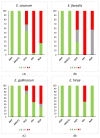In Vitro Evaluation of Phytobiotic Mixture Antibacterial Potential against Enterococcus spp. Strains Isolated from Broiler Chicken
- PMID: 38732016
- PMCID: PMC11084370
- DOI: 10.3390/ijms25094797
In Vitro Evaluation of Phytobiotic Mixture Antibacterial Potential against Enterococcus spp. Strains Isolated from Broiler Chicken
Abstract
Enterococcus spp. are normal intestinal tract microflorae found in poultry. However, the last decades have shown that several species, e.g., Enterococcus cecorum, have become emerging pathogens in broilers and may cause numerous losses in flocks. In this study, two combinations (H1 and H2) of menthol, 1,8-cineol, linalool, methyl salicylate, γ-terpinene, p-cymene, trans-anethole, terpinen-4-ol and thymol were used in an in vitro model, analyzing its effectiveness against the strains E. cecorum, E. faecalis, E. faecium, E. hirae and E. gallinarum isolated from broiler chickens from industrial farms. To identify the isolated strains classical microbiological methods and VITEK 2 GP cards were used. Moreover for E. cecorum a PCR test was used.. Antibiotic sensitivity (MIC) tests were performed for all the strains. For the composition H1, the effective dilution for E. cecorum and E. hirae strains was 1:512, and for E. faecalis, E. faecium and E. gallinarum, 1:1024. The second mixture (H2) showed very similar results with an effectiveness at 1:512 for E. cecorum and E. hirae and 1:1024 for E. faecalis, E. faecium and E. gallinarum. The presented results suggest that the proposed composition is effective against selected strains of Enterococcus in an in vitro model, and its effect is comparable to classical antibiotics used to treat this pathogen in poultry. This may suggest that this product may also be effective in vivo and provide effective support in the management of enterococcosis in broiler chickens.
Keywords: E. cecorum; Enterococcus spp.; broiler; osteomyelitis; phytobiotics; resistance genes.
Conflict of interest statement
The authors declare no conflicts of interest. The funders had no role in the design of the study; in the collection, analyses or interpretation of data; in the writing of the manuscript; or in the decision to publish the results. Author Karolina A. Chodkowska was employed by the company Ferma Podolany Spółka z o.o. The remaining authors declare that the research was conducted in the absence of any commercial or financial relationships that could be construed as a potential conflict of interest. Authors Hubert Iwiński and Henryk Różański were employed by the company AdiFeed Spółka z o.o. The remaining authors declare that the research was conducted in the absence of any commercial or financial relationships that could be construed as a potential conflict of interest.
Figures





Similar articles
-
In Vitro Assessment of Antimicrobial Activity of Phytobiotics Composition towards of Avian Pathogenic Escherichia coli (APEC) and Other E. coli Strains Isolated from Broiler Chickens.Antibiotics (Basel). 2022 Dec 15;11(12):1818. doi: 10.3390/antibiotics11121818. Antibiotics (Basel). 2022. PMID: 36551476 Free PMC article.
-
Prevalence and antibiotic resistance of Enterococcus strains isolated from poultry.Acta Vet Hung. 2016 Jun;64(2):148-63. doi: 10.1556/004.2016.016. Acta Vet Hung. 2016. PMID: 27342087
-
Culture methods impact recovery of antibiotic-resistant Enterococci including Enterococcus cecorum from pre- and postharvest chicken.Lett Appl Microbiol. 2017 Mar;64(3):210-216. doi: 10.1111/lam.12705. Lett Appl Microbiol. 2017. PMID: 27987523
-
A Review of Enterococcus cecorum Infection in Poultry.Avian Dis. 2018 Sep;62(3):261-271. doi: 10.1637/11825-030618-Review.1. Avian Dis. 2018. PMID: 30339512 Review.
-
An Updated Review of Enterococcus cecorum Infections in Poultry.Avian Dis. 2025 Apr;68(S1):404-411. doi: 10.1637/aviandiseases-D-24-00098. Avian Dis. 2025. PMID: 40249579 Review.
Cited by
-
Invasion of Chicken Intestinal Cells Is Higher for Enterococcus cecorum Lesion Strains Compared to Cloacal Strains in an Organoid Model.Microorganisms. 2024 Dec 31;13(1):50. doi: 10.3390/microorganisms13010050. Microorganisms. 2024. PMID: 39858818 Free PMC article.
References
-
- Rehman M.A., Yin X., Zaheer R., Goji N., Amoako K.K., McAllister T., Pritchard J., Topp E., Diarra M.S. Genotypes and Phenotypes of Enterococci Isolated from Broiler Chickens. Front. Sustain. Food Syst. 2018;2:83. doi: 10.3389/fsufs.2018.00083. - DOI
-
- European Centre for Disease Prevention and Control . Annual Epidemiological Report 2011. ECDC; Stockholm, Sweden: 2011. Reporting on 2009 surveillance data and 2010 epidemic intelligence data. - PubMed
MeSH terms
Substances
LinkOut - more resources
Full Text Sources
Medical
Molecular Biology Databases
Miscellaneous

